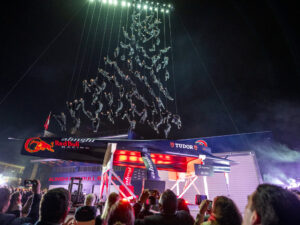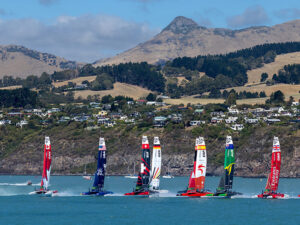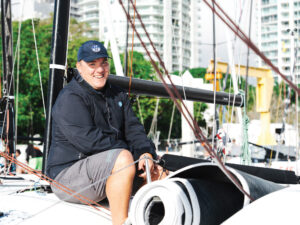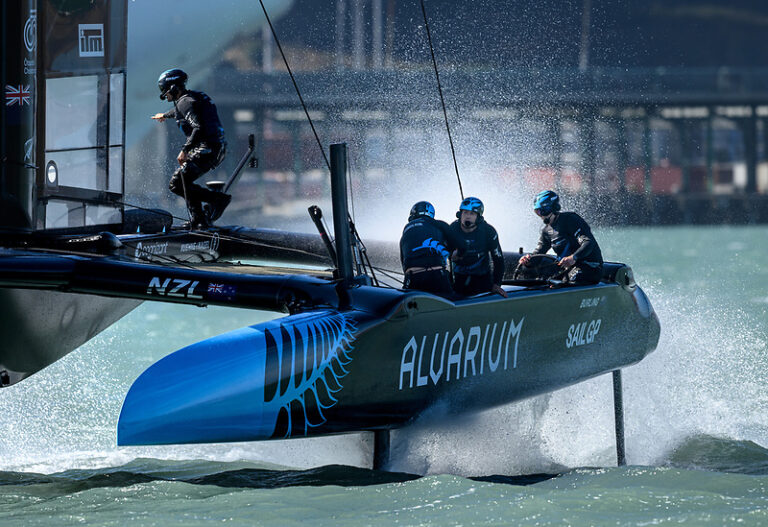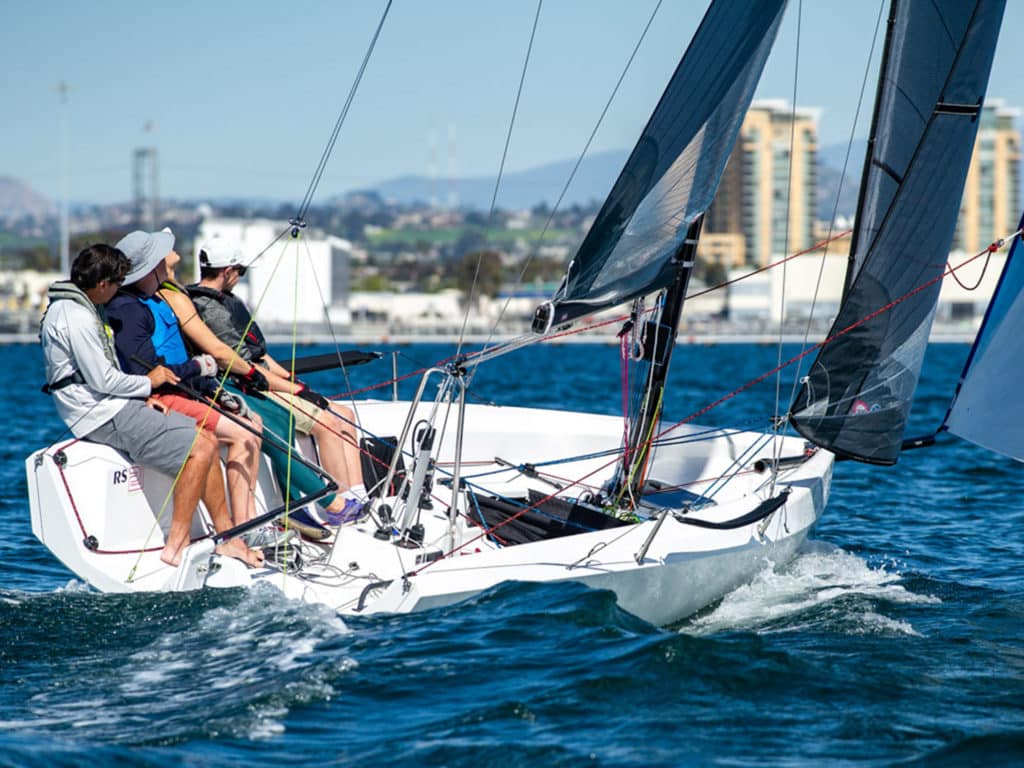
For the last year and a half, I’ve been practicing once a month with Bob Martin, from San Diego, in the Lightning. A couple of years ago he asked me to coach him because the 2018 Lightning North Americans were in San Diego. He did pretty well—first to the weather mark a number of times and ended up a respectable 12th overall. He decided to do the NAs the following year at the Buffalo Canoe Club in Ontario, Canada, and asked me to sail with him. Because the Lightning fleet in San Diego is small, and to make logistics easier, we decided to practice on our own. Using experience I had from coaching Point Loma High School for 15 years, I thought, “OK, this will work—I’ll organize and manage the sessions while we’re out there, make it fun, and set up specific goals for each day.”
We did this once a month. We’d talk about our goals before we went out and debrief when we got in, nothing too formal—just chatting for 10 minutes or so. After some reflection, Bob or I would send out an email to the three of us about what we thought we learned and what we might work on next time.
The NAs was our only big regatta together as a team. We had a bad first race—a 25—then we got four top-five finishes in a row. Going into the last day, which would have kicked in our drop, we had the least number of points. But there was no wind, so we never got a chance to drop that 25 and try to win it. We still ended up a satisfying third. A lot of our success can be credited to our solo practice sessions. They were fun, we became good friends while doing it, and we were successful at the regatta. The best things to practice when by yourself are boathandling and starting, but don’t be fooled into thinking you can’t practice boatspeed. Many think you need another boat, and that certainly helps, but you can make still progress on your own, so all three areas are fair game in a solo-practice session.
Identify goals
In our Lightning training, we often emailed people we knew, such as Skip Dieball or Greg Fisher, to ask questions like, “We were going upwind yesterday and we got overpowered. Should we be dropping the traveler or putting on backstay?” Their answers provided goals for the next time we went out, and we’d practice what they told us. We were active about those goals, seeking out knowledge from people better than us, with more experience than us in the boat, and then executing it.
We also set other goals, such as sailing upwind with the right heel angle, getting the controls right so the power was right, good sets, douses, and jibes, as well as being smooth, sailing to the compass, and starting.
Mix up what you do; the best practices involve a variety of things. The majority of focus might be on, say, sailing downwind. In a Laser, this might mean focusing on body movement to surf waves, or maybe working on sailing by the lee. That can be your main focus, but also think about what you want to practice when going upwind, because you need to go upwind in order to go downwind. Or, you might put in some starting practice before heading back upwind.
Short bursts of intensity
The late great basketball coach John Wooden said he always tried to make his practices a little faster-paced, more difficult than an actual game. Then, when his players got into the game, everything was slower and felt easier. When I manage a practice, I try to do the same thing. If you feel comfortable doing a half-mile windward-leeward course, make it a shorter leg, so it’s a little faster paced than you’re comfortable with, and keep doing it until you get it right. And maybe the next day, make it shorter. When you do get on the racecourse, you have the mental capacity to relax and just look around and call better tactics because your boathandling is solid.
Depending on your usual level of intensity while racing, shoot for a total of 10 to 20 minutes of really intense work for each skill you’re working on. For example, if your tacks are normally around a minute apart, tack every 30 seconds. Or jibe every 30 seconds. Do that for 5 minutes. Take a break and then do it again—and maybe again. You get better by pushing yourself harder than you normally would in a race. It also makes you feel like you accomplished something. It’s like if you’re at the gym and you normally do 20 situps, do 21 or 25. You feel like you made a gain, and you have. It’s the same thing here. Hike a little harder than you normally would for five or 10 minutes, tack more often, or jibe more often. Then take a break. Stop sailing. Have some water, food, or just hang out for a minute or two.
There is a slight caveat to this. Let’s say your focus for the day is sailing downwind. You need to get back upwind to do the drill again, and most people will start casually working their way back upwind. Instead of sailing the entire distance in the casual mode, throw in one or two 10-minute sessions with a bunch of tacks, or maybe focus on heel angle, or compass heading—whatever you feel you need to work on. Pretend you’re in a race—look for pressure, shifts, and try to put the boat in the most wind that you can find. Then switch back to the casual mode again. Now, you’ve not only been efficient with your time, but you’ve maintained your intensity.
Starts and starts
Starting well boils down to two things—knowing where the starting line is and being able to put your boat, at full speed, near it at the gun. So time and distance is huge, and that’s something you can really practice by yourself. All you need to practice starting is one mark.
Depending on your boat, do 2-minute rolling or 3-minute rolling starts so you can be efficient and get in a lot of repetitions. In a Laser, a 2-minute rolling start is about right. Your goal is to make each start as real as possible. Let’s say you do 10 starts in a row, with a rolling 2 minutes. Pretend the mark is the boat and the line is to the left of it, and do five starts that way. Then, for the next five starts, pretend the mark is the pin and the line is to the right of it. The main goal is to be full speed, closehauled, not adjusting any controls, within a foot or two of that mark, or right on it if you’re using it as a pin. You’re not turning, you’re not trimming in, you’re not slow, and you’re right beside the mark.
In the Lightning, we realized it takes 12 seconds to get up to speed in 8 knots of wind and smooth water. So, if I’m not trimmed in and going before 12 seconds, or I’ve put the boat too close to the starting line and can’t trim in before 12 seconds, I’ve made a mistake. I need to put my boat in a spot that’s far enough away that I can trim in before 12 seconds. I shouldn’t be turning, which slows the boat down, trimming in, adjusting the backstay, traveler or anything else. I’m perfectly set. That’s the Bill Hardesty rule—1 second before the gun everything is perfect. Practice that for 10 to 30 minutes. Keep doing it until you get good at it. It’s tough to do. But it will take your starting to a much higher level.
Be sure to pretend there are boats around you. Let’s say you’re a little too close to the line at 15 seconds so you bear away to a beam reach to build speed and kill time. If it was a real start, you probably couldn’t do that. Or, if you’re a couple of boatlengths to the right of the boat layline with 15 seconds to go, there’s probably going to be someone to leeward of you squeezing you out. So, you need to work in a narrow band of space, as if it’s a real starting line, pretending as if there’s someone to leeward and windward.
Mark roundings done right
If good mark roundings are your goal, every time you see a mark, round it, whether it’s upwind or down. It’s like a game of leap frog. If there are no marks, improvise by sailing loops. In the Lightning, we’d set the spinnaker, sail downwind for a little bit, then douse and head back up. Then we’d tack, pretend we were on the offset leg, put the pole up and set. If you’re sailing a 1-mile downwind leg, you could do loops of five to 10 sets and douses instead of just one of each at the ends of the leg. You can do little loops while sailing upwind or downwind. If you’re in a Laser, practice bearing off around a mark, hike hard, make the boat heel to windward, bear away, get all the controls set, then pretend that 50 yards away is a leeward mark. Maybe it’s a crab pot, or just an imaginary mark. Round it, get the controls back on, and go upwind. You’ll get in a lot more boathandling practice than if you just sailing straight.
Boatspeed awareness
As mentioned earlier, people commonly think another boat is required to practice boatspeed, but that’s not true. There is plenty to focus on when sailing solo. Maintaining a stable heel angle is so important to speed, as is setting up your boat so that it has the proper amount of power for the conditions—powered up in light air, depowered in heavy air, and everything in between. Those are all things you can practice to improve boatspeed. Other things—being smooth, tacking on headers, jibing on lifts—are all part of boatspeed.
Let’s say you’re sailing upwind and you get a 10-degree header. You can bear away 10 degrees, then head up and tack through 90, and you will have just steered through a total of 100 degrees. Or, if you get that header and immediately roll into a tack, you now have tacked through 80 degrees. Doing so, you are now leading on the long tack compared to people who bear away, then tack, so you’re bow out, going up the course toward the mark. The best tacks and jibes are the ones where you instantly jibe on the lifts or you instantly tack on the headers. You can practice the same thing downwind. Assume you’re sailing along and get a lift. You head up 10 degrees, conclude you’re riding a lift and jibe through 90 degrees. Once again, you just steered through 100 degrees. World-class sailors sense the lift, think, “That’s a lift,” and they immediately jibe. They’re jibing through 80 degrees while you’re jibing through 100, meaning they are sailing less distance as well as leading toward the next shift.


